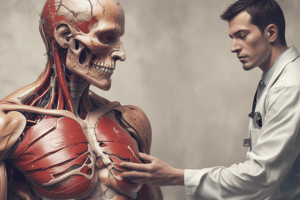Podcast
Questions and Answers
What percentage of thoracic deaths worldwide are accounted for by thoracic injury?
What percentage of thoracic deaths worldwide are accounted for by thoracic injury?
- 15-20%
- 20-25% (correct)
- 30-35%
- 25-30%
What type of injury is caused by falls, MVA, acceleration-deceleration injuries, crush injuries, and shearing forces?
What type of injury is caused by falls, MVA, acceleration-deceleration injuries, crush injuries, and shearing forces?
- Penetrating injury
- Transfixing injury
- Blunt injury (correct)
- Deceleration injury
What is a unique feature of the pediatric thorax that helps it absorb forces?
What is a unique feature of the pediatric thorax that helps it absorb forces?
- More fat
- More cartilage (correct)
- More bone
- More muscles
What is the goal of the initial evaluation in thoracic trauma?
What is the goal of the initial evaluation in thoracic trauma?
Which of the following is NOT a physiological cause of death in thoracic trauma?
Which of the following is NOT a physiological cause of death in thoracic trauma?
What is the primary survey in ATLS?
What is the primary survey in ATLS?
What is the treatment for flail chest?
What is the treatment for flail chest?
What is a common associated injury with sternal fractures?
What is a common associated injury with sternal fractures?
What is the prevalence of myocardial contusion in autopsy series of patients with blunt cardiac injury?
What is the prevalence of myocardial contusion in autopsy series of patients with blunt cardiac injury?
What is the recommended management for myocardial contusion?
What is the recommended management for myocardial contusion?
What is the mortality rate in blunt aortic injuries?
What is the mortality rate in blunt aortic injuries?
What is the typical site of blunt aortic injuries?
What is the typical site of blunt aortic injuries?
What is a radiographic feature associated with thoracic aortic injury?
What is a radiographic feature associated with thoracic aortic injury?
What is a clinical feature of blunt aortic injuries?
What is a clinical feature of blunt aortic injuries?
What is a management option for blunt aortic injuries?
What is a management option for blunt aortic injuries?
What is the mortality rate in blunt aortic injuries within 6 hours?
What is the mortality rate in blunt aortic injuries within 6 hours?
What is the most common site of tracheobronchial tree injuries?
What is the most common site of tracheobronchial tree injuries?
What is the percentage of patients with tracheobronchial tree injuries that can be missed for years?
What is the percentage of patients with tracheobronchial tree injuries that can be missed for years?
What is the main difference between pulmonary contusion and pulmonary hematoma?
What is the main difference between pulmonary contusion and pulmonary hematoma?
What is the mortality rate associated with sternal fractures?
What is the mortality rate associated with sternal fractures?
What is the main mechanism of tracheobronchial tree injuries?
What is the main mechanism of tracheobronchial tree injuries?
What is the primary investigation for tracheobronchial tree injuries?
What is the primary investigation for tracheobronchial tree injuries?
What is the treatment for haemothorax?
What is the treatment for haemothorax?
What is the indication for surgical exploration in haemothorax?
What is the indication for surgical exploration in haemothorax?
What is the percentage of tracheobronchial tree injuries that reach hospital setting?
What is the percentage of tracheobronchial tree injuries that reach hospital setting?
What is the complication of pulmonary hematoma?
What is the complication of pulmonary hematoma?
What is the primary approach for managing tracheobronchial tree injuries based on the location and extension?
What is the primary approach for managing tracheobronchial tree injuries based on the location and extension?
What is the primary management for acute foreign body in the airway?
What is the primary management for acute foreign body in the airway?
What is the most common type of esophageal injury?
What is the most common type of esophageal injury?
What is the primary diagnostic investigation for esophageal injuries?
What is the primary diagnostic investigation for esophageal injuries?
What is the primary management for esophageal injuries within 24 hours?
What is the primary management for esophageal injuries within 24 hours?
What is the primary complication of esophageal injuries?
What is the primary complication of esophageal injuries?
What is the most common type of foreign body in the esophagus?
What is the most common type of foreign body in the esophagus?
What is the primary diagnostic investigation for diaphragmatic injuries?
What is the primary diagnostic investigation for diaphragmatic injuries?
What is the primary management for cardiac injuries?
What is the primary management for cardiac injuries?
What is the primary pathology of blunt cardiac injuries?
What is the primary pathology of blunt cardiac injuries?
Flashcards are hidden until you start studying
Study Notes
Thoracic Trauma
- Thoracic trauma accounts for 20-25% of traumatic deaths worldwide
- Male and female distributions are equal, with a peak incidence in the 20-30 age group
- Mechanisms of injury: penetrating, blunt, and transfixing
- Penetrating: high velocity (gunshot wounds) and low velocity (stab wounds)
- Blunt: direct (assault and blast), indirect (falls, MVA, crush injuries, and shearing forces)
- Transfixing
Pediatric and Geriatric Thorax
- Pediatric thorax: more cartilage, absorbs forces, and has a higher incidence of respiratory failure
- Geriatric thorax: calcification and osteoporosis, more fractures
Acceleration-Deceleration Injuries
- Shearing, tearing, and traction forces on structures with varying degrees of fixation
- Aorta, heart, and esophagus are susceptible to injury
Initial Evaluation
- Goal: prompt identification of life-threatening injuries
- Physiological causes of death: tissue hypoxia, hypercarbia, metabolic acidosis
- ATLS primary survey: airway, breathing, circulation
- Secondary survey: systematic evaluation with imaging
Traumatic Rib Fractures
- Sternal fractures: 4%, transverse, in the upper or mid-portions
- Associated injuries: myocardium, scapula, and clavicle
- Mortality: 10%
Pleura
- Traumatic pneumothorax: may be missed initially, erect CXR must exclude during 2nd survey
- Haemothorax: associated with penetrating or blunt chest trauma with bony injury
Lung Injury
- Clinical: haemoptysis, pneumothorax, haemothorax
- Management: severity of injury, ICD, and chest physiotherapy
- Surgery: suture, wedge resection, pulmonary tractotomy, lobectomy, and pneumonectomy
Pulmonary Contusion
- Blunt trauma, high-energy impact, and potential lethality
- Clinical features: subsequent respiratory failure, slow progression
- Diagnosis: CXR/CT chest
- Management: supportive, oxygen, analgesia, pulmonary toilet, intubation (significant hypoxia, pre-existing conditions)
Tracheobronchial Tree Injuries
- Central airways, common after blunt injury, high-energy impact
- Mechanism: forceful AP compression, high airway pressure, and rapid deceleration injury
- Site: cervical trachea most common
- Clinical features: missed in >30% of patients, high suspicion in mediastinal emphysema, subcutaneous emphysema, pneumothorax, and haemoptysis
Esophageal Injuries
- Rare, blunt trauma, and penetrating (stab or trans-mediastinal gunshot injury)
- Clinical features: pneumothorax, haemothorax without rib fractures, lower sternum or epigastric pain
- Investigations: combination of clinical suspicion, CXR, water-soluble contrast swallow, oesophagogram, and oesophagoscopy
- Management: surgical repair or resection with delayed reconstruction
Diaphragmatic Injuries
- Often occult, easily missed, and detected on the left
- Marker of severe thoracoabdominal trauma
- Clinical features: with or without signs of bowel obstruction, drainage of peritoneal content via chest drain
- Investigations: CXR, swallow and follow-through, contrast-enhanced CT scan
- Management: surgical repair = thoracotomy vs. thoraco-abdominal incision vs. laparotomy, laparoscopy
Cardiac Injuries
- Penetrating and blunt cardiac injuries
- Pathology: patchy areas of muscle necrosis, hemorrhagic infiltrate, rupture of small vessels
- Clinical features: cardiac tamponade, arrhythmias, and heart failure
- Investigations: ECG, cardiac enzymes, formal ECHO/TEE
Surgery
- Elective or urgent, depending on the severity of injury
- Myocardial rupture: simple cardiorrhaphy, pledgetted sutured
- Mitral valve: repair/replacement
- Tricuspid: repair
- IVS: traumatic VSD-closure
Great Vessel Injuries
- Aorta most commonly injured in severe blunt or penetrating trauma
- 85-95% mortality, typically patients survive the initial injury insult
- Mechanisms: acceleration-deceleration, shearing forces, and direct luminal compression
- Site: isthmus, near ligamentum arteriosum
- Clinical features: death on the scene, rapid exsanguination, expanding thoracic inlet hematoma, bruit, hypotension, pulse deficit
Studying That Suits You
Use AI to generate personalized quizzes and flashcards to suit your learning preferences.




